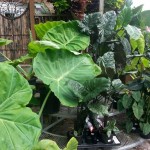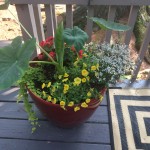I love Elephant Ears, they are my favorite tropical. They look great on their own or planted with annuals for the spring and summer months. Elephant ears are grown for their large, dramatic, heart-shaped leaves.
Elephant Ears are a “Summer Bulb“, which means they cannot over winter in the ground. They are similar to a Gladiola or a Dahlia. They originate from warmer climates, where they do well in the ground all year. But in our climate, they need special winter care.
Elephant Ears respond to warm day and night temperatures. Since they are not a perennial, it is best to containerize them and enjoy in partial to full sun on a patio or deck. If full sun, they must be well watered and not allowed to dry out. Use a large pot (at least 16” in diameter) to help hold the water and provide a sturdy base for this big plant.
Once the weather starts to change, becoming colder and introducing the possibility of frost, you need to make a decision on where and how you will overwinter your pot of Elephant Ears.
- If your plant is still small and you have a spot in your house, you may wish to leave it intact and bring it in as a houseplant. When bringing it into your house it is a good idea to spray the trunk and soil with an insecticidal soap (avoid the leaves unless you see a pest problem) and place the pot in a shady spot for two or three days.
- Once in your home Elephant Ears should have lots of light and be watered regularly because of the drying conditions associated with most home heat sources. Trim off yellow leaves and the plant will continue to grow, although more slowly, throughout the winter.
- If your plant is too big to put in your living area you can consider a more drastic method, that of chopping off all the foliage and stalk at soil level and bringing the pot and bulb to overwinter in your house. Since the leaves are not actively growing, you can put it in a moderately lit location where it won’t freeze, such as a basement near a small window or a spare bedroom. It is not attractive at this point, as you are simply maintaining the bulb in a dormant state for the future. Water monthly and small leaves will begin to form.
- In early May, you can put your pot outside, making sure it is sheltered on frosty nights. It will grow slowly in the Spring but once June hits and the weather is warmer, it will thrive! Remove yellow leaves as needed and keep it watered and fertilized with a basic all-purpose fertilizer (20-20-20). This is when I like to add additional plants to the base of the plant to make it a beautiful summer pot featuring this incredible tropical.
Enjoy!

